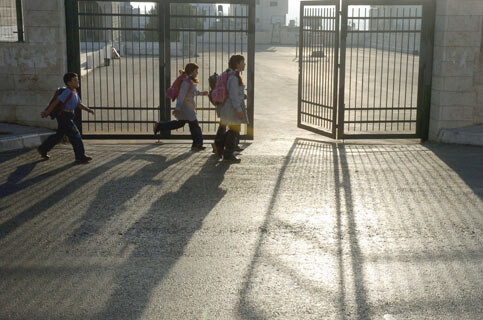United Nations Relief and Works Agency for Palestine Refugees in the Near East 3 January 2006

Palestinian students on their way to the first school day of the new semester in the West Bank town of Ramallah September 3, 2005. (MAANnews/Mushir Abdelrahman)
NABLUS -– Nestled in the golden hills surrounding Nablus in the West Bank, the little town of Till is home to 3,000 people. Like many population centres in this conflict-prone area, children’s access to safe-play and recreational facilities has been virtually non-existent…until recently.
Just a few months ago, UNICEF helped create Till’s first-ever safe-play area for children.
“For me, there’s a big difference between before the playground was built and after,” says nine-year-old Majdi Ramadan, a 4th grade student who lives in Till with his family. “I used to play in the streets, but we were always interrupted when people walked by. It was dangerous, too, with all the cars; one of my friends got hurt. Now I’m no longer afraid of the cars, I can just play.”
So far, 20 safe-play areas have been created in the occupied Palestinian territory: 11 in the Gaza strip and nine in the West Bank. These play areas provide an estimated 30,000 children with opportunities to meet, socialize and play in a protected environment.
In some locations, UNICEF designed family-friendly spaces also provide activities involving parents, providing much-needed relief.
“Before, the children would play in the streets or around the house,” says Majdi’s mother, Fatima Ramadan. “When they played around the house, they would often destroy the plants, damage the trees and accidentally break all sorts of things. When they played in the streets, I was so afraid for them, especially because of the cars. So, really, there wasn’t anywhere for them to play. I’m happy we now have this playground and I like the fact that they can take part in so many activities that are new to them.”
Structured activities such as group games and sports are conducted each week to draw children away from the streets and restore a sense of routine in their daily lives. To manage and maintain the areas, local management committees have been set up in each location. They’re made up of parents, community members, NGOs and children themselves. These committees alert the municipality whenever there are maintenance issues that need to be attended to. The committees also organize activities for the safe-play areas and keep the place clean.
“I love playing in the playground! I love the swings, they’re my favourite!” says Majdi’s 12 year-old sister, Shada Ramadan. “I usually go to the play area with my friends after school. What I like best is to buy some sweets and share them there with all my friends. I guess that for me the playground is like an escape, I’m not afraid there.”
UNICEF’s safe-play areas are part of the United Nations Child Friendly Cities initiative, helping fulfil children’s right to play and promote their well-being.
Related Links





